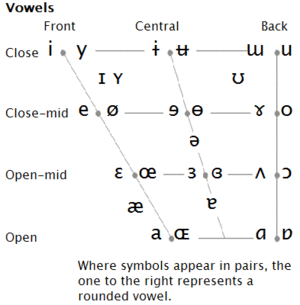Vowel (definition)
Phonetically, a vowel (V) is a sound produced with a fairly open configuration of the vowel tract and the vibration of the vocal folds; notably, articulators in the vocal tract are adequately distant so as not to create audible frication. Vowels typically form the nuclei of syllables and are often described with the following features:
- The rounding of the lips,
- The frontness or backness of the tongue body,
- The height of the tongue body,
- The tenseness of the gesture (see also Advanced Tongue Root (definition)),
- The nasality of the sound, and
- The length of the acoustic signal.
In the graphic on the right, a segment's placement in the trapezoid approximates its place of articulation and corresponds with its height and backness (i.e. [i] has +high and +front features). Although many of the features listed above reference articulatory gestures, vowel quality is often determined by the acoustic properties of the signal. First and second format frequencies are commonly used to identify and distinguish between vowels, where F1 contains inverse height information and F2 communicates backness information.
For a complete description of Gaelic consonants and its phoneme inventory, see the main article at Sounds of Scottish Gaelic.
See Also
External Links
- Interactive IPA Charts
- http://akerbeltz.org/index.php?title=Vowels
- http://akerbeltz.org/index.php?title=Unstressed_vowels
The link below takes you away from the Gaelic Wiki to Wikipedia. Since wikipedia pages can be edited by anyone, they often contain inaccurate information. So be careful!
References
- Crystal, David. (1997) A Dictionary of Linguistics and Phonetics. Oxford, UK: Blackwell.
- Ladefoged, Peter (1993) A Course in Phonetics Third Edition. London: Harcourt Press.
- Matthews, P. H. (1997) The Concise Oxford Dictionary of Linguistics. Oxford: Oxford University Press.
